Prepared by Marianne Cusato, HomeAdvisor’s Housing Expert and a Professor of the Practice at the University of Notre Dame’s School of Architecture
TABLE OF CONTENTS
- Executive Summary
- Summary of Key Findings
- Aging in Place: Myths versus Realities
- The Future of Aging in Place: User-Centered Design
- Recommendation: Rebranding & Education
- Conclusion
- TechnologEASE
- Survey Methods
- About
For the PDF version of this report, click here: AIP 2016 Report
EXECUTIVE SUMMARY
It’s time to elevate the conversation about aging in place. Forget about grab bars and wheelchair ramps. Those are elements of last resort for “old” people. And who wants to be labeled “old”? Not me, and I suspect not you, either.
The problem with aging is that there isn’t a single point at which we are officially “old.” All other major life events—graduating from college and starting a career, for instance, or getting married and starting a family—have a clear starting point. Not aging. It’s not only gradual, but also different for each of us individually. Long before our hips fail us, we might be a little shaky on our feet. Years before we need memory care, we could become unsure of our decisions or forgetful. Aging is relative. Some people are born “old.” Others are young into their nineties.
Yet despite all of these vagaries, we do know several things for sure: America has an aging population with an increasing life expectancy, most of whom desire to stay in their homes indefinitely as they age. In fact, already 108.7 million strong, the population of Americans age 50 and older is expected to swell by another 10 million—nearly 10 percent—by 2020, according to AARP1. The number of Americans age 85 and older, meanwhile, is expected to more than triple by 2060, making them the fastest-growing age group in the country2. Americans aren’t merely aging, however; they’re also living longer, according to the U.S. Census Bureau, which says a baby born in 2015 will live to an average age of 79.4 while one born in 2060 will live to an average age of 85.63. Someone born in 1950, on the other hand, has an average life expectancy of just 684.
So how do we meet the housing needs of an aging population that plans to stay in their homes, but won’t admit that they are aging? Simple: We must change the discourse related to housing and aging. The dialog must be about adding features that enhance our lives today by offering a return on investment through livability … yet also happen to support the process of aging gracefully. Let’s rebrand “aging in place”—an activity for old people—and start a discussion, instead, about “thriving in place”: a goal for all people.
The findings in HomeAdvisor’s Annual Aging-in-Place Report are the perfect backdrop against which to start this new discussion. Drawn from two recent HomeAdvisor surveys—one of 279 home service professionals and the second of 586 homeowners over the age of 55—this report highlights current industry and demographic trends while making the case for actionable “thriving in place” solutions that homeowners of all ages can implement today.
SUMMARY OF KEY FINDINGS:
Baby Boomers Hesitant to Invest in Aging-Related Home Upgrades
With 61 percent of homeowners over the age of 55 planning to stay in their homes indefinitely, it’s surprising that few older homeowners are investing in aging-related improvements. In fact, 65 percent believe their home’s layout is adequate without any aging-related improvement, and over three-quarters of homeowners (78 percent) have never completed an aging-related renovation.
Older Homeowners Want to Thrive in Place, Not Age
There is a disconnect between the perception of aging in place—adding grab bars and install- ing wheelchair ramps—and the reality: that many design features can enhance the livability of a home for all ages. Among homeowners who’ve never considered an aging-in-place renovation, 40 percent say it’s because they don’t have a physical disability that requires it; 20 percent say they don’t consider themselves old enough yet for such a project.
Smart Home Technology Increases Safety and Livability
Smart home technology can provide solutions for homeowners looking to increase their safety, accessibility and easy of living. Two-thirds (67 percent) of homeowners over age 55 believe smart-home technology could help them age in place, yet fewer than 1 in 5 (19 percent) have actually considered installing it for such purposes.
AGING IN PLACE: MYTHS VS. REALITIES
By 2032, Americans over age 50 are expected to account for more than half of U.S. GDP, according to AARP. Today, the growing over-50 population already is responsible for at least
$7.1 trillion in annual economic activity across the United States5. If this demographic had its own country, it would have the third largest GDP in the world behind the United States and China and ahead of Japan, which have GDPs of $17.95 trillion, $10.98 trillion and $4.12 trillion, respectively.
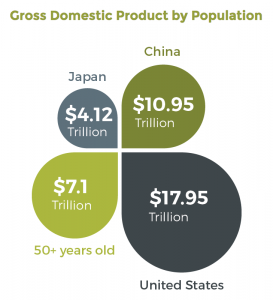
“There are several economic reasons for homeowners to start on ‘thriving in place’ projects sooner rather than later,” said Brad Hunter, HomeAdvisor’s Chief Economist. “If homeowners start early, they can spend sufficient time researching and planning to avoid wasted time and suboptimal solutions. And, homeowners can protect, and possibly even raise resale value of the home by making the home more appealing to buyers in all age groups with modifications that have a broad appeal.”
Myth: Aging in Place is a Conversation for ‘Old’ People
Among homeowners 55 years old or older, 61 percent are planning to stay in their home indefinitely as they age, citing as their most common reasons that they feel independent in their current home (68 percent), their current home is conveniently located (66 percent), they feel safe in their own home (66 percent), they’re familiar with their neighborhood (54 percent) and they live close to family (38 percent). However, HomeAdvisor found that homeowners over age 70 (77 percent) are more likely to want to stay in their home than homeowners age 56-70 (56 percent).
One explanation for the gap is that older homeowners already are aging in place, as homeowners who plan to move likely have done so by the time they reach their seventies.On the other hand, another explanation could be that homeowners don’t yet feel “old” enough to be having aging-in- place conversations. In fact, HomeAdvisor found only 22 percent of homeowners have completed an aging-in-place renovation, and nearly a third (31 percent) have never even considered one. Among the latter, the most common reasons homeowners gave for not considering an aging-in-place renovation are that they don’t have any physical disabilities requiring such renovations (40 percent) and they don’t consider themselves old enough to need them (20 percent).
Why Are Homeowners Choosing to Age in Place?
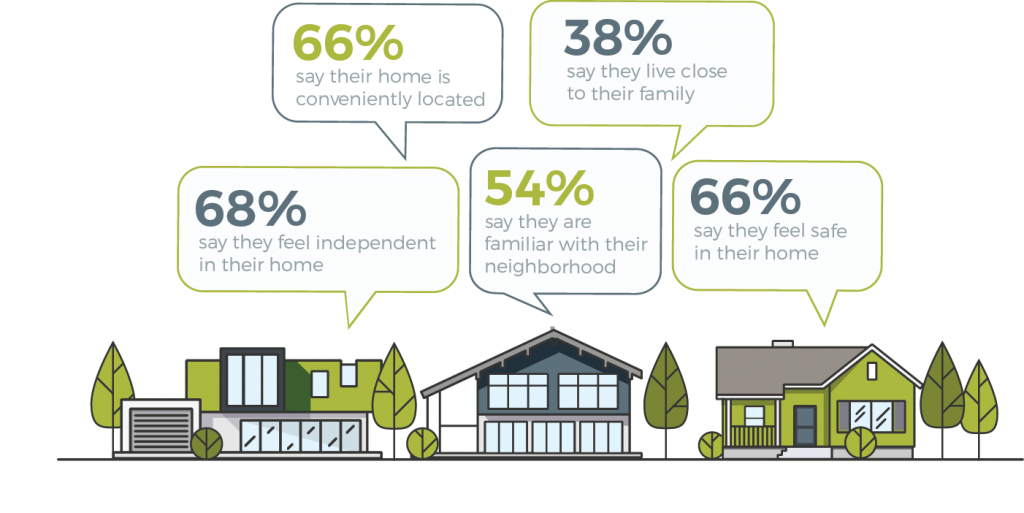
Reality: The Best Time to Think About Aging in Place is … Now
Because nobody wants to age, it’s not surprising that most homeowners wait until they’re in their seventies to proclaim their intentions to “age in place.” “Thriving in place” by making their home more livable, on the other hand, is something everyone wants to do—regardless of their age. A young mom, for example, can get excited about a kitchen remodel that includes a pot filler over the stove and base drawers instead of lower cabinets, both of which make her kitchen more functional when she’s preparing meals for her family. Likewise, an urban bachelor who’s redoing his bathroom can feel enthused about putting bench seating in his new steam shower so he can take a relaxing steam after a long day on his feet at work. It just so happens that the same features that help these younger homeowners thrive in their homes will help their older selves do the same. It’s all about maximizing comfort, convenience and, as a result, happiness.
“Aging in place isn’t about special add-on features that will only help you once you’ve fallen and incurred a disability,” says Rodney Harrell, Ph.D., director of Livable Communities at AARP’s Public Policy Institute. “It’s about making functional home improvements that make spaces more useful and more usable for anyone, anytime.”
Reasons for Not Completing Aging-Related Renovations
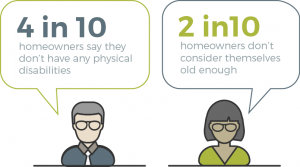
Myth: Aging in Place is About Aging
Most homeowners over age 55 (67 percent) say they consider themselves to be proactive about making aging-in-place renovations, and a majority (86 percent) feel they are familiar with aging-in-place additions, remodels or products.
Home service professionals tell a different story: More than half (57 percent) of the home service professionals HomeAdvisor surveyed indicate that aging-in-place projects account for less than 10 percent of the work requests they receive. Furthermore, only 20 percent of pros say most homeowners who contact them about aging-in-place projects reach out proactively, before they have immediate home improvement needs; most say homeowners reach out reactively because they or someone they know has a degenerative condition that will limit their independence over time (33 percent), because of a recent hospitalization or major medical event (25 percent), or because they’re concerned about a recent fall or minor medical event (19 percent).
Finally, most pros say the primary reasons homeowners hire them to do aging-in-place renovations are accessibility (50 percent) and safety (43 percent); only 6 percent say homeowners hire them to make “ease-of-living” improvements like lowering countertops or installing low-maintenance landscaping.
All of this indicates that homeowners want to be proactive about aging in place, but are held back by misconceptions that aging-in-place projects will prematurely “senior-proof” their home.
Reality: Aging in Place is About Livability
Making homes safe and accessible for seniors is an important and primary objective of aging- in-place projects. Thriving in place, however, is about much more than adding grab bars and wheelchair ramps. In fact, many popular aging-in-place improvements—wider doorways, open
floor plans, zero-step entrances, remote-controlled window coverings and motion-sensor lights, just to name a few—can enhance the quality of life in a home even as they make the home safer. Such improvements are often “invisible” and can be just as beneficial to a homeowner in his thirties or forties as they are to a homeowner in her seventies or eighties.
“Think differently,” Harrell says. “If you’re renovating a kitchen or bathroom, do things in a way that makes sense. Making your space more usable for yourself today will also make it more usable for your future self.”
Myth: Smart Home Technology is Simply for Convenience
Although a majority of homeowners over age 55 (67 percent) think it could be helpful as they age, just 19 percent say they have considered installing smart-home technology for that reason. This is likely because homeowners still think of technology as a luxury convenience rather than a practical necessity. In fact, homeowners who haven’t considered smart-home technology to assist them with aging in place cite as their most common reasons that they don’t need/are not interested in such technology (45 percent), that it’s too expensive to purchase (29 percent) and that it’s too expensive to install (25 percent).
Reality: Smart Home Technology Supports Independence
Smart-home technology—for example, Internet-connected thermostats, appliances and lighting—is a new frontier that holds significant promise for helping Americans age in place comfortably and safely while also adding significantly to their home’s present livability. Consider, for example, a connected refrigerator that automatically detects when groceries run low and orders new ones when needed; the same appliance that creates convenience for a young family can ensure nourishment for a homebound senior.
Older homeowners’ reluctance to adopt smart-home technology for aging in place is not surprising. Older adults are less likely than younger adults to be familiar with technology in general, and smart-home technology in particular is still coming into existence—and, therefore, still expensive. Over time, however, the so-called “digital divide” will close and prices will fall. That, along with a new conversation about thriving instead of aging in place, will lead to increased adoption of smart-home technology for livability instead of luxury.
Myth: Aging in Place is Only Practical in the Suburbs
Among homeowners over age 55, 65 percent say the physical layout of their home will be suitable as they age. However, those who live in suburban/rural homes (67 percent) are more likely to believe this than those who live in urban homes (50 percent). Likewise, suburban/ rural homeowners are less likely than urban homeowners to have completed or considered an aging-in-place renovation: Just 21 percent of suburban/rural homeowners have already completed an aging-in-place renovation and 34 percent of them have never considered one, compared to 31 percent and 15 percent, respectively, among urban homeowners. Together, these data suggest a shared belief that it’s easier to age in place in suburban and rural homes than it is in urban homes.
Reality: Cities Have Unique Aging-in-Place Advantages
Suburban and rural homes may be easier to modify for aging-in-place purposes, but that doesn’t automatically make them more suitable for older adults. In fact, the AARP Public Policy Institute in 2015 launched a new, first-of-its-kind tool highlighting the social components of aging in place. Called the AARP Livability Index, it allows people of all ages to determine—at the neighborhood level—how well their community is positioned to meet their current and future needs based on a comprehensive range of metrics, including not only housing, but also transportation, environment and health, among others7. Thanks to their superior public transit and increased social opportunities, urban communities often receive a higher “livability” score than rural and suburban ones.
THE FUTURE OF AGING IN PLACE: USER-CENTERED DESIGN
When he noticed that his arthritic wife, Betsey, was having trouble holding a vegetable peeler, industrial designer Sam Farber decided to make her a better one. After studying hundreds of existing peelers and ideating dozens of new ones, he finally arrived at a design whose comfortable, cushioned handle suited Betsey perfectly. In 1990, Farber launched OXO with that and 14 other ergonomically designed “OXO Good Grips” kitchen tools. Today, the company has more than 1,000 home products whose comfort and ease of use make OXO the brand of choice not merely for arthritic homemakers, but for consumers of all ages, occupations and abilities.
Farber’s approach to design—serving those with special needs by designing products that meet everyone’s needs—represents the future of aging in place.
Accessibility advocates call it “universal design.” Industrial designers like Farber call it “user- centered design.” Either way, the principle is the same: Improvements that make homes livable only for some (e.g., raised toilet seats, chair lifts, walk-in tubs) risk making them appealing to none. Improvements that make homes universally more livable (e.g., replacing lower cabinets with pull out drawers, large windows providing natural light), however, will make them appealing to everyone as we age.
Surveys Highlight Top Renovation Projects
What Room Is the Most Popular for Aging-Related Renovations?
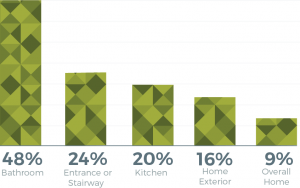
Homeowners over age 55 say the bathroom (48 percent) is the top area in the home that they have considered modifying
for aging in place; a minority have considered modifying an entrance or stairway (24 percent), the kitchen (20 percent), the exterior (16 percent) or their overall home, including bedroom (9 percent).
Likewise, homeowners say the top aging-in-place projects they’ve considered are: installing grab bars around the tub or shower, or installing a shower seat (48 percent); increasing the height of their toilet (28 percent); installing adjustable/handheld showerheads (23 percent); installing base cabinets with rollout trays and lazy Susans (15 percent); planting low-maintenance shrubs and plants (15 percent); and adding handrails on either side of stairways (12 percent).
Home service professionals, meanwhile, say the top aging-in-place projects they’ve been hired to do are installing grab bars (71 percent), adding entryway wheelchair ramps (54 percent) and increasing the widths of doorways (43 percent).
These findings reinforce the false perception that aging-in-place renovations are reserved only for situations where they are medically necessary and highlight the need to change the conversation from aging-in-place projects that no one wants to thriving-in-place projects that everyone can embrace.
RECOMMENDATIONS: REBRANDING & EDUCATION
Planning ahead to address the needs of an aging population is not a challenge. Rather an exciting opportunity to create as much functional equity as financial equity.
A New Message: ‘Thriving in Place’
As HomeAdvisor’s data show, homeowners are unwilling to prematurely surrender their homes and lives to old age just because they’ve reached retirement age. And rightly so. Instead of avoiding falls and coping with arthritis, they intend to spend their retirement years indulging their passions, cultivating new hobbies and making lasting memories with loved ones. Instead of discouraging them from pursuing their goals, their homes should help them achieve them.
That was Sam Farber’s vision when he created the OXO Good Grips vegetable peeler, and it’s the vision that will help society rise to the occasion of housing an aging population whose members plan to live independently at home for as long as they possibly can.
As previously outlined in this report, realizing this vision requires picking up Farber’s torch and using it to ignite a new conversation that rebrands, redefines and repositions “aging in place” as “thriving in place.” Because when Americans of all ages thrive in their homes, they enjoy more happiness, a better quality of life and—thanks to proactive investments that make their homes more viable for longer—increased financial security. And as citizens and taxpayers, that benefits all of us.
Next Step: Education
The first step toward a national dialog about thriving in place is education, suggests HomeAdvisor’s data. Nearly half (45 percent) of homeowners over age 55 say they are not at all interested in learning more about aging in place, they show, and only 7 percent say they would be interested in receiving a free aging-in-place assessment from a home service professional.
This indicates a compelling opportunity for home service professionals, who say they are ready and willing to help homeowners thrive in place.
In fact, a majority of home service professionals (84 percent) already offer aging-in-place services to homeowners. And while more than half (54 percent) say they don’t yet offer educational information about aging in place to their customers, nearly half (46 percent) do. Those who do say the most common aging-in-place topics they educate their customers about are: the types of aging-in-place projects they can do (83 percent); aging-in-place safety (54 percent); options for aging in place, such as staying in your own home or moving in with a family member (38 percent); and technology for aging in place (21 percent).
Although only a third (34 percent) of pros consider themselves to be “very” or “extremely” knowledgeable about aging-related products and renovations, most are open to learning more, with 61 percent indicating that they could benefit from training on aging-related home repairs. The training topics they’re most interested in are: the most common types of aging-in- place projects (57 percent), technology available for homeowners over age 50 (54 percent) and how to install specific aging-related products (44 percent).
In the years ahead, pros’ enthusiasm for professional development in this area will no doubt help them change the aging-in-place conversation to one that’s focused on thriving in homes instead of surviving in them.
CONCLUSION
“Aging in place” is a misnomer. Whether we’re 25, 45, 65 or 85, our homes aren’t for aging. They’re for thriving. From pancake breakfasts with our kids and Sunday brunches with our friends to holidays with family, movie nights with our spouses and curling up with a good book, our homes are where we do the things we love to do, with the people we love to do them with. Looking at aging in place through a new lens that acknowledges how we live—not just how long we live—will usher in a new generation of home-improvement projects that benefit the young, the young at heart and everyone in between.
TechnologEASE: 7 Life-Simplifying Smart-Home Gadgets for Thriving in Place
Smart-home technology isn’t just for tech-savvy homeowners or those with an in-house technical team — i.e., kids. In fact, the current generation of smart-home gadgets is providing comfort, convenience and safety to a huge variety of homeowners, from first-home couples to retirees. Here are the top seven smart-home technologies that are making it possible to thrive in place — regardless of age:
SURVEY METHODOLOGY
Data included in the Aging-in-Place Report is based on results from a survey conducted by Qualtrics on behalf of HomeAdvisor. The survey was fielded from August 10, 2016- August 23, 2016 to 279 professional respondents, of whom 235 reported completing 235 aging-related tasks and 586 homeowner respondents, all of whom 586 reported being age 55 years old or older.
Works Cited:
1. AARP. (2014). Getting to Know Americans Age 50+. Retrieved Sept. 16, 2016, from http://www.aarp. org/content/dam/aarp/research/surveys_statistics/general/2014/Getting-to-Know-Americans-Age- 50-Plus-Demographics-AARP-res-gen.pdf.
2. Fox-Grage, Wendy. (2016, March 11). “The Skyrocketing of the Age 85+: AARP Data Explorer Provides Long-Term Services and Supports Data for Policy Solutions.” AARP Blog. Retrieved Sept. 16, 2016, from http://blog.aarp.org/2016/03/11/the-skyrocketing-of-the-age-85-aarp-data-explorer-provides-long- term-services-and-supports-data-for-policy-solutions.
3. U.S. Census Bureau. (2014, December). “Table 17. Projected Life Expectancy at Birth by Sex, Race, and Hispanic Origin for the United States: 2015 to 2060.” Retrieved Sept. 16, 2016, from http://www. census.gov/population/projections/data/national/2014/summarytables.html.
4. U.S. Department of Housing and Urban Development. (2013, Fall). “Aging in Place: Facilitating Choice and Independence.” Evidence Matters. Retrieved Sept. 16, 2016, from https://www.huduser.gov/ portal/periodicals/em/fall13/highlight1.html.
5. AARP. (2013, October). “The Longevity Economy: Generating Economic Growth and New Opportunities for Business.” Retrieved Sept. 16, 2016, from http://www.aarp.org/content/dam/aarp/ home-and-family/personal-technology/2013-10/Longevity-Economy-Generating-New-Growth-AARP. pdf.
6. The World Bank. (2015). “Gross Domestic Product 2016.” Retrieved Sept. 16, 2016, from http:// databank.worldbank.org/data/download/GDP.pdf.
7. AARP. (2015, April 20). “AARP: Is Your Neighborhood Livable Today and In the Future? New Livability Index Helps People Assess, Plan For Needs and Wants.” News Release. Retrieved Sept. 16, 2016, from http://www.aarp.org/about-aarp/press-center/info-04-2015/aarp-livability-index.html.
8. OXO. “Our Roots.” Retrieved Sept. 16, 2016, from https://www.oxo.com/our-roots.
ABOUT MARIANNE CUSATO
Marianne Cusato is HomeAdvisor’s Housing Expert and a Professor of the Practice at the University of Notre Dame’s School of Architecture. Cusato is a designer, author and lecturer whose work speaks to the ever-changing needs of homeowners striving to balance the practical requirements of economy and durability with the desire to love where we live.
ABOUT HOMEADVISOR
HomeAdvisor is a nationwide digital home services marketplace providing homeowners with tools and resources for their home repair, maintenance and improvement projects. HomeAdvisor’s marketplace lets homeowners view average project costs coast-to-coast using True Cost Guide, find local prescreened home professionals, and instantly book appointments online or through HomeAdvisor’s award-winning iOS and Android mobile app. HomeAdvisor is based in Golden, Colo., and is an operating business of IAC (NASDAQ: IAC).
Contact
For more information about this report or HomeAdvisor.com, please contact:
Steffanie Finkiewicz
Public Relations Manager
SFinkiewicz@HomeAdvisor.com
303-963-8030
For the PDF version of this report, click here: AIP 2016 Report
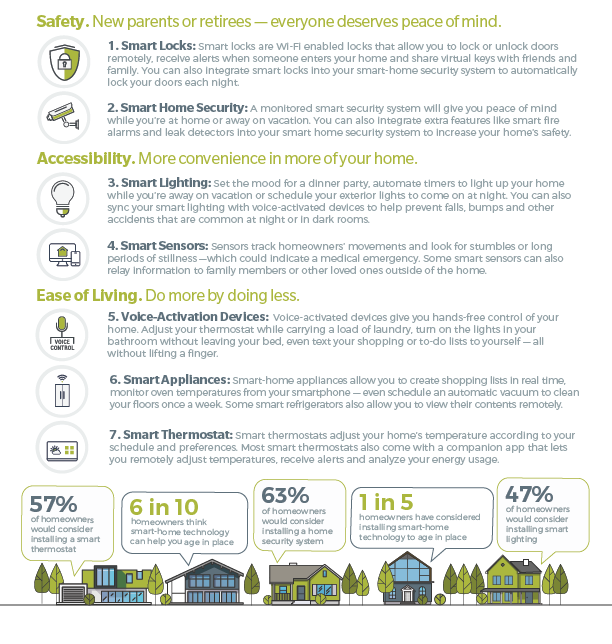
 Home Adaptations for Your Needs
Home Adaptations for Your Needs  Home Modification Programs for Aging in Place Home Services
Home Modification Programs for Aging in Place Home Services  Modern Design Trends & Advice for Aging in Place
Modern Design Trends & Advice for Aging in Place  Preparing Your Business for the Aging-in-Place Boom
Preparing Your Business for the Aging-in-Place Boom  Budget-Friendly Smart Home Accommodations for Seniors and Individuals with Special Needs
Budget-Friendly Smart Home Accommodations for Seniors and Individuals with Special Needs 

Are You Familiar With This Topic? Share Your Experience.